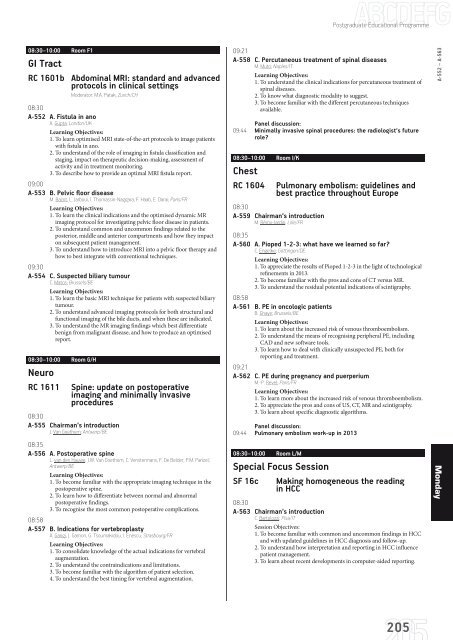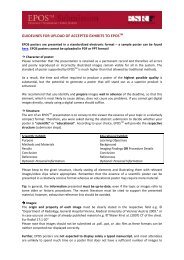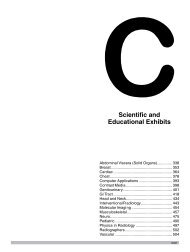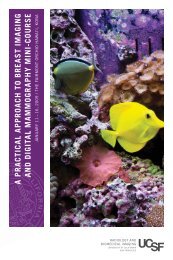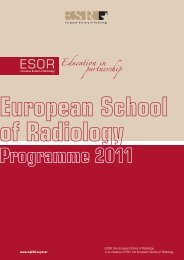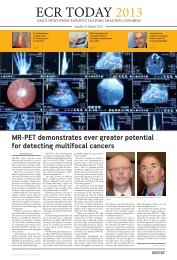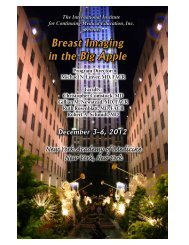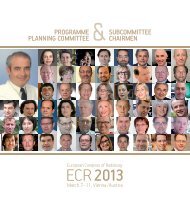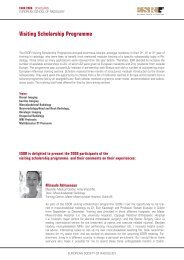ECR 2013 â Final Programme - myESR.org
ECR 2013 â Final Programme - myESR.org
ECR 2013 â Final Programme - myESR.org
- No tags were found...
Create successful ePaper yourself
Turn your PDF publications into a flip-book with our unique Google optimized e-Paper software.
Postgraduate Educational <strong>Programme</strong>08:30–10:00 Room F1GI TractRC 1601b Abdominal MRI: standard and advancedprotocols in clinical settingsModerator: M.A. Patak; Zurich/CH08:30A-552 A. Fistula in anoA. Gupta; London/UKLearning Objectives:1. To learn optimised MRI state-of-the-art protocols to image patientswith fistula in ano.2. To understand of the role of imaging in fistula classification andstaging, impact on therapeutic decision-making, assessment ofactivity and in treatment monitoring.3. To describe how to provide an optimal MRI fistula report.09:00A-553 B. Pelvic floor diseaseM. Bazot, L. Jarboui, I. Thomassin-Naggara, F. Haab, E. Darai; Paris/FRLearning Objectives:1. To learn the clinical indications and the optimised dynamic MRimaging protocol for investigating pelvic floor disease in patients.2. To understand common and uncommon findings related to theposterior, middle and anterior compartments and how they impacton subsequent patient management.3. To understand how to introduce MRI into a pelvic floor therapy andhow to best integrate with conventional techniques.09:30A-554 C. Suspected biliary tumourC. Matos; Brussels/BELearning Objectives:1. To learn the basic MRI technique for patients with suspected biliarytumour.2. To understand advanced imaging protocols for both structural andfunctional imaging of the bile ducts, and when these are indicated.3. To understand the MR imaging findings which best differentiatebenign from malignant disease, and how to produce an optimisedreport.08:30–10:00 Room G/HNeuroRC 1611Spine: update on postoperativeimaging and minimally invasiveprocedures08:30A-555 Chairman‘s introductionJ. Van Goethem; Antwerp/BE08:35A-556 A. Postoperative spineL. van den Hauwe, J.W. Van Goethem, C. Venstermans, F. De Belder, P.M. Parizel;Antwerp/BELearning Objectives:1. To become familiar with the appropriate imaging technique in thepostoperative spine.2. To learn how to differentiate between normal and abnormalpostoperative findings.3. To recognise the most common postoperative complications.08:58A-557 B. Indications for vertebroplastyA. Gangi, J. Garnon, G. Tsoumakidou, I. Enescu; Strasbourg/FRLearning Objectives:1. To consolidate knowledge of the actual indications for vertebralaugmentation.2. To understand the contraindications and limitations.3. To become familiar with the algorithm of patient selection.4. To understand the best timing for vertebral augmentation.09:21A-558 C. Percutaneous treatment of spinal diseasesM. Muto; Naples/ITLearning Objectives:1. To understand the clinical indications for percutaneous treatment ofspinal diseases.2. To know what diagnostic modality to suggest.3. To become familiar with the different percutaneous techniquesavailable.Panel discussion:09:44 Minimally invasive spinal procedures: the radiologist‘s futurerole?08:30–10:00 Room I/KChestRC 1604Pulmonary embolism: guidelines andbest practice throughout Europe08:30A-559 Chairman‘s introductionM. Rémy-Jardin; Lille/FR08:35A-560 A. Pioped 1-2-3: what have we learned so far?C. Engelke; Göttingen/DELearning Objectives:1. To appreciate the results of Pioped 1-2-3 in the light of technologicalrefinements in <strong>2013</strong>.2. To become familiar with the pros and cons of CT versus MR.3. To understand the residual potential indications of scintigraphy.08:58A-561 B. PE in oncologic patientsB. Ghaye; Brussels/BELearning Objectives:1. To learn about the increased risk of venous thromboembolism.2. To understand the means of recognising peripheral PE, includingCAD and new software tools.3. To learn how to deal with clinically unsuspected PE, both forreporting and treatment.09:21A-562 C. PE during pregnancy and puerperiumM.-P. Revel; Paris/FRLearning Objectives:1. To learn more about the increased risk of venous thromboembolism.2. To appreciate the pros and cons of US, CT, MR and scintigraphy.3. To learn about specific diagnostic algorithms.Panel discussion:09:44 Pulmonary embolism work-up in <strong>2013</strong>08:30–10:00 Room L/MSpecial Focus SessionSF 16c Making homogeneous the readingin HCC08:30A-563 Chairman‘s introductionC. Bartolozzi; Pisa/ITSession Objectives:1. To become familiar with common and uncommon findings in HCCand with updated guidelines in HCC diagnosis and follow-up.2. To understand how interpretation and reporting in HCC influencepatient management.3. To learn about recent developments in computer-aided reporting.A-552 – A-563Monday205


